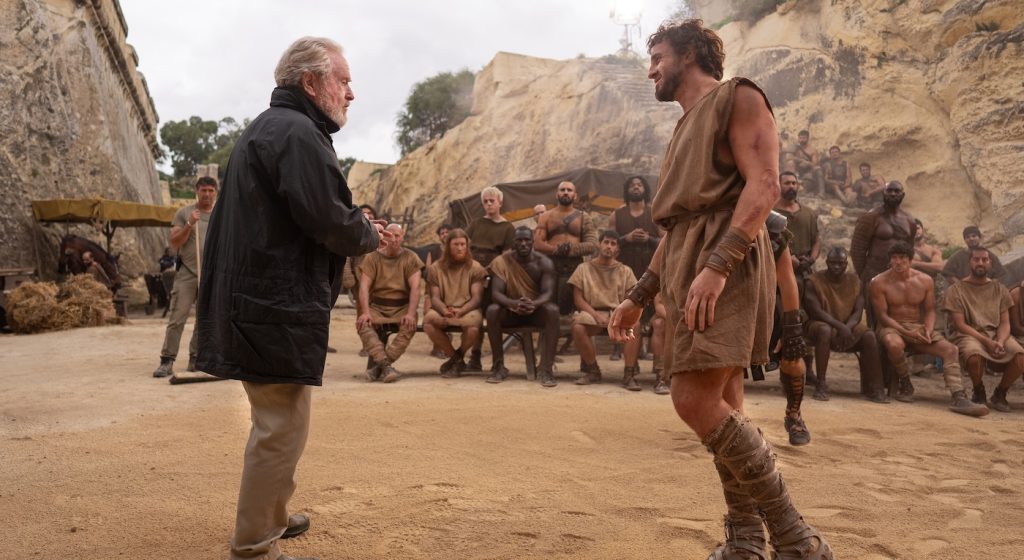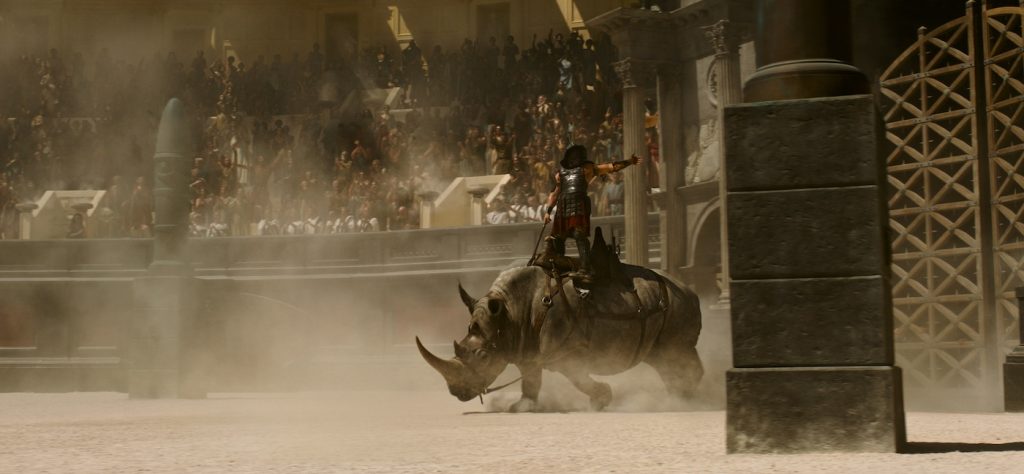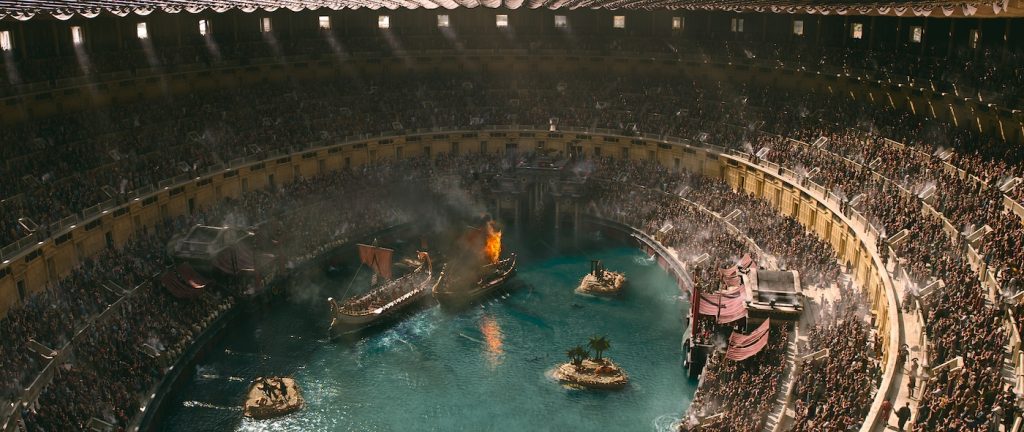How “Gladiator II” Editors and the VFX Supervisor Shaped Three Ferocious Scenes
Gladiator II picks up fifteen years following the events of Russell Crowe’s portrayal of Maximus Decimus Meridius in Gladiator (2000), an epically visceral film from Ridley Scott that not only won five Oscars, including Best Picture at the 73rd Academy Awards but is considered one of the greatest action films in movie history – a notion underpinned by its quotable dialogue that has become part of the public lexicon.
Scott tapped Napoleon (2023) scribe David Scarpa to carve out the sequel based on a story by Peter Craig (The Batman), which follows a now grownup Lucius (Paul Mescal) – who is revealed to be the son of Maximus and Lucilla (Connie Nielsen) – living with his wife Arishat (Yuval Gonenthe) in the Numidia empire (roughly northeast Algeria today). It’s not until invading Romans, led by General Acacius (Pedro Pascal), that he finds himself in a similar situation to his father – a widower fighting to stay alive for the amusement of the Colosseum mob.
Scott brings scale to the narrative through its production design and cinematography, with action sequences bigger, bloodier, and more complex than the original. Editors Sam Restivo and Claire Simpson, along with visual effects supervisor Mark Bakowski, shaped scenes with emotional weight and visceral realism. Below, they discuss what went into crafting three key sequences and share which one almost didn’t make the film at all.
Rival Consequences
The opening action sequence in Gladiator II has Lucius fighting General Acacius and the Roman fleet as they invade his village of Numbida by sea. It’s the first time the characters clash, but it won’t be the last.

How did you want to introduce the audience to these characters through the edit?
Sam Restivo: We knew we were introducing two of the big stars of the movie, and most of the time, Lucius is the star of the film, so we wanted to give him plenty of weight. That’s why we had the scene with Arishat [Yuval Gonen] establishing his relationship with his wife and with the head of the Numdians and their struggle against the encroaching Romans. We knew it would be a massive way to start the movie. The first assembly was something like 20-plus minutes long, which is a little too exhausting to ask for an audience to sit through something like that, so a lot of the editing for us was finding the right overall length because when Ridley’s shooting with 12 cameras, the options are amazing.

Claire Simpson: It was definitely a complicated scene, and Mark [Bakowski] and his visual effects team did a brilliant job because we shot it in the desert. Three makeshift boats were standing in sand dunes, so when we were assembling it we had to use our imaginations actually to think of this big vista of boats and everything.

Mark, how did your team marry the practical elements with the VFX work?
Mark Bakowski: The sequence was shot in Morocco on the Kingdom of Heaven set, where Ridley shot before. The logic to that is that he knows its geography, and that set was extended slightly for this movie. Obviously, it’s in the middle of the desert, so there’s no water, so right from the start, Neil Corbett, who’s the special effects supervisor, found these giant machines on wheels that could drive parts of the ship around in the desert. Then we knew we would have to add lots of digital water and environment, fire and smoke, to integrate behind everything as we go.
When Acacius and the Romans make their way onto land, what went into balancing the emotional arc between these two main characters while still showcasing the chaos of war?
Claire Simpson: Well, you always have to follow your stars, so Lucius and Acacius were the key elements. Once you’ve got that throughline, you can embellish it with all the other stuff. War is chaos, no matter how you look at it, and to treat it as anything other than sheer and utter mayhem would be cheating.
Mark Bakowski: Coming from the direction of Ridley, we would try to stuff every frame with as much as we possibly could. It was like, oh, there’s a place where we could put an explosion in the background. Yeah, let’s do that. So, we were adding to the chaos as much as we could.
A Bloodthirsty Kill
As a captured slave, Lucius fights as a gladiator inside the Colosseum, and in one such clash, he faces a warrior riding atop an enormous rhino, a sequence Ridley Scott considered including in Russel Crowe’s Gladiator. By its conclusion, Lucius viscously lops off his opponent’s head.

There’s a bit of a crescendo to the scene as the rhino repeatedly charges at Lucius before going into hand-to-hand combat with the rider. How did you want to build the intensity to the moment leading up to its ultimate climax?
Sam Restivo: It’s an intuitive thing. Claire and I are audience members ourselves. We’re watching this movie and we’re kind of following our own feelings and our own taste for how long these moments should last. Once Lucius does this thing where he’s like, no mercy, and then he fights the guy, the actual moment of him deciding to behead the guy, there are a few different slow-mo shots. That was done to extend the moment of his decision-making to make it the most viscerally impactful way to end the scene.

What visual effects work went into creating the beastly rhino?
Mark Bakowski: It was a collaboration between special effects and visual effects. The rhino was a full-sized robot on wheels that could be radio-controlled by someone off-camera. The top part had a gate to it, which is very important because that gives you, when it’s charging around, the actor or stunt actor riding on top has to react to when the rhino is moving. It gave that physicality into the actor and an eyeline for the actors to react. Then, we kept the saddle and the rider, and we replaced the rhino in visual effects because it didn’t have legs. In some shots, when the gallop of the rider was slightly wrong because he wasn’t moving enough, we would replace him for those shots. But it was never the ambition. We’d always try to keep the real thing anytime we could.

One of the characters in both Gladiator films is the Colosseum mob. How did you want to connect the crowd’s energy to the emotional weight of what’s unfolding?
Claire Simpson: Well, that’s a very good question because that’s the hardest thing we had to do. Originally, we gathered all kinds of sound effects, but they were mostly stadium and modern football crowds, and we couldn’t get the right feel at all. So Danny Sheehan [supervising sound editor at Phaze UK] and Matt Collinge, our sound supervisor, came to the set, grabbed a bunch of people, and put them in the stands. They directed them and tailored the sound effects for each scene. It was brilliant how they did it because we couldn’t do it with our stock sound effects.
Sam Restivo: During the final mix, it gave us so much flexibility because they had so many different things. We’re figuring out as we go, like what we need to feel. What does the crowd need to feel? Because Ridley was very specific about wanting exact tones going on, and credit to Matt and Danny for getting all of this material to give us the flexibility to solve that on the mix stage.
Swimming with Sharks
During a climactic battle, Lucius is aboard an attacking ship inside a flooded Colosseum. Swimming below is a school of hungry sharks. Sinking his enemy is his only means of survival.

The naval battle scene is gratifyingly entertaining. Did you have anything to lean into while creating it in the cutting room?
Claire Simpson: That’s all due to Ridley, really, because he had mapped it all out in storyboards. Initially, the studio didn’t want to do it because they thought it was much too complicated and expensive, but we thought it would be spectacular if we could pull it off. And so Ridley was able to get his way, and he storyboarded it all out. He’s got a prodigious imagination.
Sam Restivo: We also shortened that sequence a bit because more things were happening, like more guys getting eaten by sharks. But we just needed to compact it to the right length to tell the story because the whole point is about Lucius’s chance to take out Acacius. So we wanted to get to that as soon as we could.
There’s a dramatic moment where one ship side-swipes the other. How was that treated by visual effects?
Mark Bakowski: That sequence was practical. Most of it was shot on dry land, which means the water is CG, but there are sections of it shot in a water tank at Malta Film Studios. The ship was put on rails, and a breakaway section was put on the side so it could shatter nicely. Backgrounds were added but that’s a practical gag in the water tank. On the day, there was someone from special effects walking between the boats throwing pieces of balsa wood into the air, but it didn’t look as convincing as you’d hope it would, so we removed them and put in some more dramatic visual effects stuff.
Gladiator II is in theaters now.
For more on Gladiator II, check out these stories:
“Gladiator II” Cinematographer John Mathieson on Capturing Robotic Rhinos & Colossal Carnage
“Gladiator II” Screenwriter David Scarpa on the Herculean Task of Writing a Worthy Sequel
Maximus Effort: “Gladiator II” Production Designer Arthur Max’s on Creating Colossal Constructions
“Gladiator II” Production Designer Arthur Max on Rebuilding a Decadent, Debased Ancient Rome



